
 'Taken 2' grabs movie box office crown
'Taken 2' grabs movie box office crown
 Rihanna's 'Diamonds' tops UK pop chart
Rihanna's 'Diamonds' tops UK pop chart
 Fans get look at vintage Rolling Stones
Fans get look at vintage Rolling Stones
 Celebrities attend Power of Women event
Celebrities attend Power of Women event
 Ang Lee breaks 'every rule' to make unlikely new Life of Pi film
Ang Lee breaks 'every rule' to make unlikely new Life of Pi film
 Rihanna almost thrown out of nightclub
Rihanna almost thrown out of nightclub
 'Dark Knight' wins weekend box office
'Dark Knight' wins weekend box office
 'Total Recall' stars gather in Beverly Hills
'Total Recall' stars gather in Beverly Hills
Burning Brightly
Updated: 2012-11-22 11:14
By Wang Kaihao (China Daily)
|
||||||||
 |
|
Zhang Zhiwei carves a wax mould in preparation for the casting. Photos provided to China Daily |
A coppersmith digs into scattered historical records to revive traditional wax-mould casting, Wang Kaihao reports.
Related: Traditional Chinese wedding held in China
There is an old shabby workshop in Langshan town on the southern outskirts of Nantong, Jiangsu province. Barrels holding some unknown liquid are placed in the corner of the courtyard. A few vigilant dogs bark at newcomers. Inside, workers busily prepare to light a furnace. The room is filled with numerous half-finished copper incense burners and it is hard to believe that this is the birthplace of such delicate art. Zhang Zhiwei, a 52-year-old Nantong native, is the creator of all these pieces.
"If I have to select something I am most proud of, it must be these incense burners," Zhang says, staring at a provincial-level award certificate hanging on the wall, which proclaims his contribution to the rebirth of Xuande Lu.
Xuande Lu, or Xuande incense burner, was first made for the royal families during the reign of Xuande (1425-35) in the Ming Dynasty (1368-1644), and it is generally considered to be China's top-class copperware variety. The wealthy emperor Zhu Zhanji was a fanatical fan of such vessels.
It is said he imported large amounts of copper from Siam (today's Thailand), and he ordered the artisans to make 3,000 furnaces based on the shapes of classical Chinese porcelains.
However, few pieces circulated beyond the royal families and dignitaries. It is extremely rare to see real Xuande Lu nowadays, but its name has an allure for antique collectors and it is synonymous with the Chinese copper incense burner. During the Qing Dynasty (1644-1911) and the following period (1912-49) there were swarms of counterfeits.
Zhang says some of the most delicate replicas, applying a more-than-2,000-year-old method known as "lost-wax casting", also have very high artistic value.
There had been little record of the details of the method first used to make bronzeware, and artisans were tight-lipped about their trade secrets.
Continuous wars in the early 20th century and the anti-antique trend during the "cultural revolution" (1966-76) almost caused the technique to die out in China.
Zhang ran an advertising company in 1992 and made some money. He learned oil painting in his childhood. Although he kept painting in the following decades, he never considered art as a profession until what he describes as "destiny" took a hand.
Zhang became a Buddhist in 1998. Out of curiosity, he started learning from an older fellow Buddhist, who is a coppersmith.
"We have a saying: One incense burner represents a god," says Zhang, who greatly attributes his motive for making the incense burners to his faith.
"When I'm too involved in a restless business circle, I feel inner peace sitting in front of an incense burner to worship its unsophisticated beauty.
"So, why couldn't we make our own?"
At that time, the antique market was filled with low-quality replicas.
"Some people even used aluminum alloy as the material and cobbled the burners into identical metal moulds," Zhang says. "Can you expect to create art on the modern assembly line?"
Zhang believed it was essential to revive the "lost-wax" technique.
His senior fellows had only heard of the method but never tried it. So Zhang had to rummage through fragmented historical records for reference.
"I visited numerous old coppersmiths, checked a picture album published in Taiwan introducing Xuande Lu and kept experimenting."
Zhang says he threw more than 1 million yuan ($160,000) into trial runs for one year after he began the work in 2004, but did not succeed in making a piece of acceptable quality.
"I dared not open the furnace to see the final work because I had enough failures," Zhang recalls his toughest time.
"I almost lost all my savings but I had to continue. If I stopped without any success, I might go completely bankrupt."
Zhang's revenue in the advertising company was unable to support this gamble, and he had to simultaneously invest in rearing chickens, reviving a local heirloom known as Langshan Chicken, to make ends meet.
He finally found the traditional technique: He uses wax to carve the original moulds, and cover them with quartz powder mixed with liquid glass seven times.
After drying, the works are boiled in hot water of 80 to 90 C to melt the wax and form the quartz outer skins into the moulds for casting, where the temperature can be as high as 1,300 C.
A mould can be used to make only one incense burner, and the whole process for making the piece can last up to one month.
"If one step goes wrong, the whole process must be repeated. Even some bubbles during heating will make a work a failure."
He adds that the heating and thickness of the quartz layer is the key because the mould could easily be broken during casting.
Polishing is also a crucial process.
"The exterior should be as smooth as a baby's skin," he says. Still, Zhang regrets that his incense burners are not perfect.
"The emperor didn't care about the cost. His artisans used gold and silver to mix with copper. That luxury cannot be repeated today."
Zhang's base material is 90 percent copper, 5 percent tin; the remaining 5 percent is a formula, which he keeps secret.
He has created nearly 200 styles and his work was been listed as one of provincial intangible cultural heritages in 2011.
He is overjoyed that his work helps to sustain enthusiasm for other local cultural relics.
Bian Xueliang, 58, a former worker at a furniture factory, learned woodcarving at the age of 19. He feels sad that the younger generation is not interested in traditional artifacts.
"Most carvers migrate to more profitable industries like interior decoration," Bian says. "I also hesitated on whether to stay in the industry."
He met Zhang in 2008 and found wax-mould carving to be a new place he could use his skills.
"Wax carving is highly demanding for its details. Thanks to my years of practice, it only took a short time to adapt."
Zhang's workshop hires about 10 employees and makes about 800 incense burners a year. Pieces are priced from 10,000 to 20,000 yuan.
Yang Hongwei, a Nantong-based artwork collector, is Zhang's frequent customer.
"It is rare nationwide to see such high-level heritage production techniques of Xuande Lu, which is even more important than the work itself," Yang says. "It is a unique contribution in terms of historical responsibility."
Nevertheless, Zhang hesitates to put energy into marketing.
"As Chinese traditional culture revives in recent years, the market for incense burners is huge," Zhang explains. "If I expand my output, many will copy them, and the works' value will decrease, which will harm me and our culture."
He felt lucky when Nantong municipal government established a 4,300-square meter park - Intangible Cultural Heritages Workshop - in February for 18 heritage craftsmen to exhibit their works for free.
"This is not only a market," says Cao Jinyang, chief of the municipal office in charge of the intangible cultural heritages protection. It is a platform for the items to show their vitality and connect more with the public to promote the traditions.
"Without the production of such crafts," Cao says, "they will easily die as time goes by."
Contact the writer at wangkaihao@chinadaily.com.cn.
Ding Congrong contributed to this story.
 |
|
An award-winning replica of Xuande Lu with bamboo pattern made by Zhang was once exhibited in Australia. |
Most Viewed
Editor's Picks

|

|

|

|

|

|
Today's Top News
Health new priority for quake zone
Xi meets US top military officer
Japan's boats driven out of Diaoyu
China mulls online shopping legislation
Bird flu death toll rises to 22
Putin appoints new ambassador to China
Japanese ships blocked from Diaoyu Islands
Inspired by Guan, more Chinese pick up golf
US Weekly

|

|






